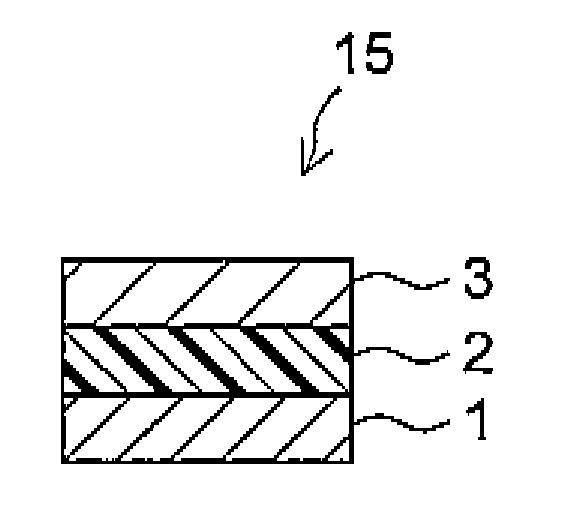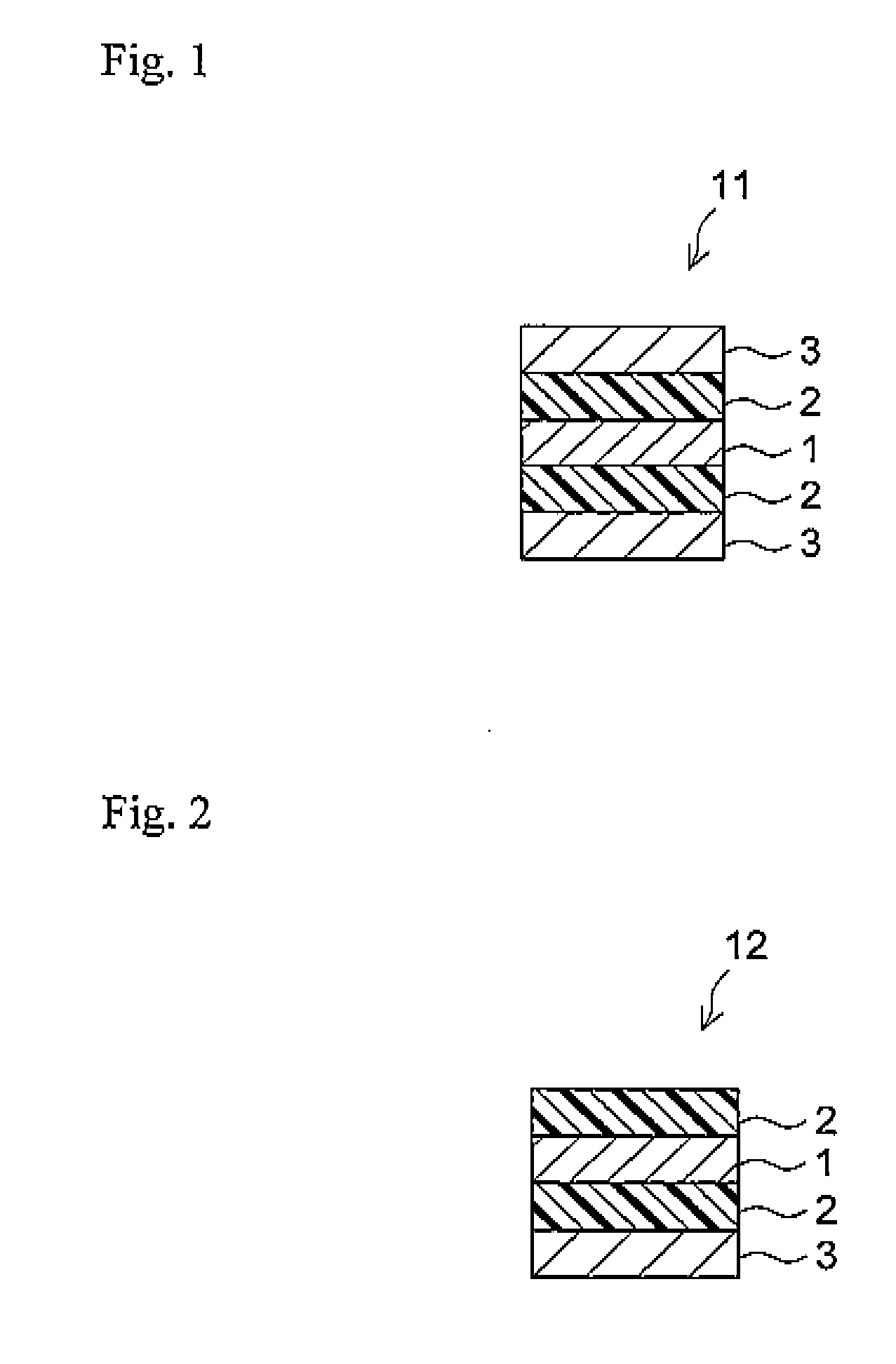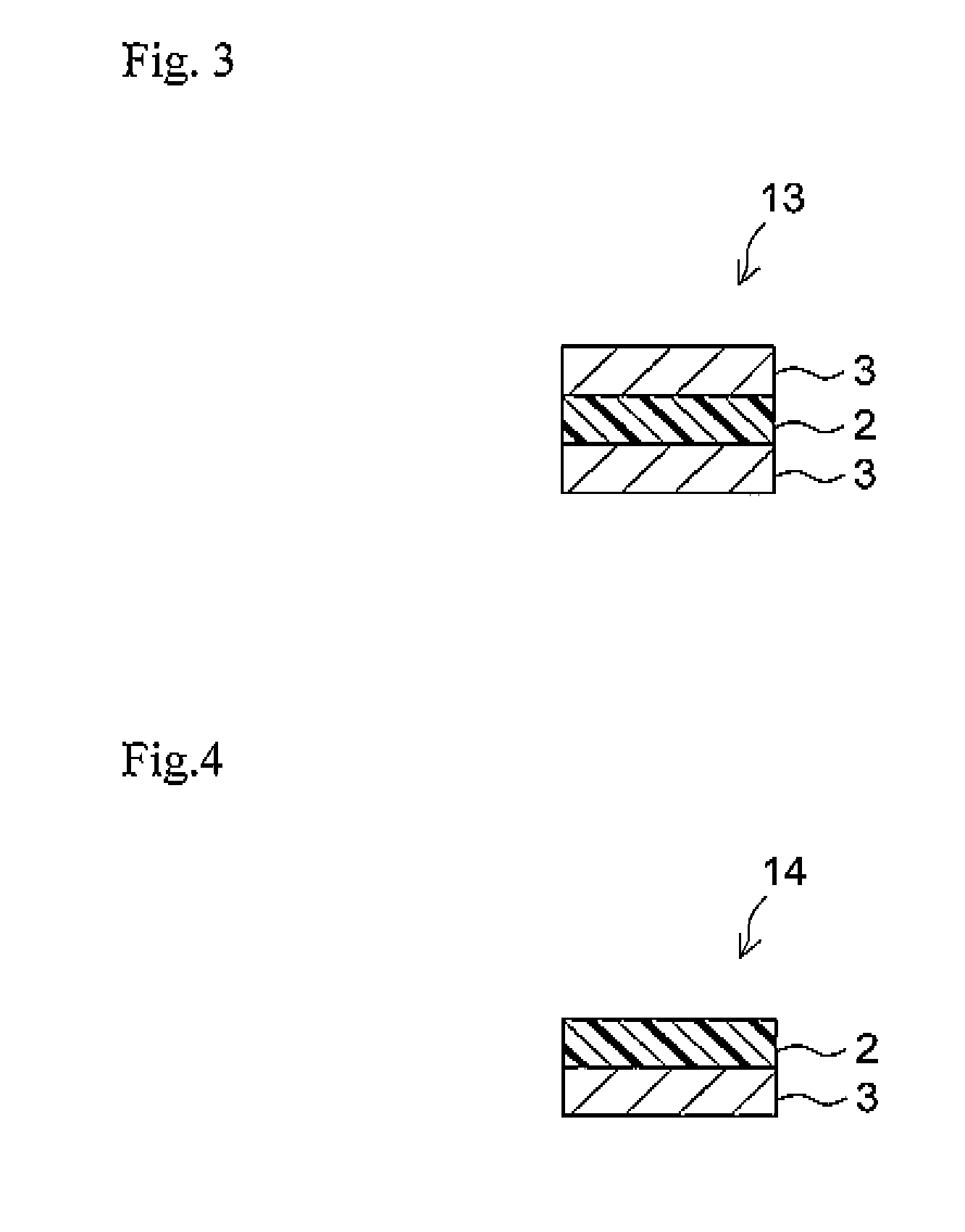[0104]In an embodiment in which the copolymerization
reaction product is a partially polymerized material (typically, in the case of adopting photopolymerization), a polyfunctional (
meth)
acrylate (namely, a monomer having two or more (
meth)acryloyl groups in one molecule thereof) can be preferably used as the crosslinking agent. Examples of the polyfunctional (meth)
acrylate include
trimethylolpropane tri(meth)acrylate,
pentaerythritol tetra(meth)acrylate, 1,2-
ethylene glycol di(meth)acrylate, 1,6-hexanediol di(meth)acrylate and dipentaerythritol hexaacrylate. From the
viewpoints of
polymerization reactivity (crosslinking reactivity) and so on, it is more preferable to use a polyfunctional acrylate. In a preferred embodiment, only at least one kind (typically one kind) of polyfunctional (meth)acrylates are used as the crosslinking agent. Alternatively, such a polyfunctional (meth)acrylate may be used in combination with other crosslinking agents (for example,
isocyanate based crosslinking agents) within the range where the effects of the invention are not remarkably impaired. A use amount of the polyfunctional (meth)acrylate can be, for example, from about 0.001 parts to 5 parts by mass based on 100 parts by mass of the monomer mixture. Preferably, the use amount of the polyfunctional (meth)acrylate is suitably from about 0.01 parts to 3 parts by mass (for example, from about 0.05 parts to 0.5 parts by mass). For example, in the case of using a
bifunctional (meth)acrylate, a larger quantity thereof may be properly chosen; whereas in the case of using a trifunctional (meth)acrylate, a smaller quantity thereof may be properly chosen. When the amount of the crosslinking agent is too small, there may be the case where a sufficient crosslinking effect is not exhibited, so that the cohesion (holding characteristic) tends to be lowered. On the other hand, when the amount of the crosslinking agent is too large, there may be the case where an
elastic modulus of the pressure-sensitive adhesive after curing becomes excessively high, so that adhesive force or tackiness is easily lowered.
[0105]In an embodiment in which the copolymerization
reaction product is a completely polymerized material (typically, in the case of adopting
solution polymerization),
epoxy based crosslinking agents,
isocyanate based crosslinking agents and so on can be preferably used. In a preferred embodiment, only at least one kind (typically one kind) of
epoxy based crosslinking agents, or only at least one kind (typically one kind) of
isocyanate based crosslinking agents are used as the crosslinking agent. Alternatively, such a crosslinking agent may be used in combination with other various crosslinking agents within the range where the effects of the invention are not remarkably impaired.
[0106]Examples of the
epoxy based crosslinking agents include epoxy based compounds having two or three or more epoxy groups in one molecule thereof, such as 1,3-bis(N,N-diglycidylaminomethyl)
cyclohexane, N,N,N′X-tetraglycidyl-m-xylenediamine, diglycidylaniline, 1,6-hexanediol
diglycidyl ether,
neopentyl glycol diglycidyl ether,
ethylene glycol
diglycidyl ether,
propylene glycol diglycidyl
ether,
polyethylene glycol diglycidyl
ether,
polypropylene glycol diglycidyl
ether,
sorbitol polyglycidyl ether,
glycerol polyglycidyl ether,
pentaerythritol polyglycidyl ether, polyglycerol polyglycidyl ether,
sorbitan polyglycidyl ether,
trimethylolpropane polyglycidyl ether, diglycidyl
adipate, diglycidyl o-
phthalate, triglycidyl-
tris(2-hydroxyethyl)isocyanurate, resorcin diglycidyl ether,
bisphenol S diglycidyl ether, 1,3-bis(N,N-diglycidylaminomethyl)
benzene, 1,3-bis(N,N-diglycidylaminomethyl)
toluene, isocyanurate, N,N,N′-tetraglycidyl-m-xylylenediamine, glycerin triglycidyl ether and
trimethylolpropane glycidyl ether. Of these, for example, 1,3-bis(N,N-diglycidylaminomethyl)
cyclohexane can be preferably used.
[0107]Examples of the isocyanate based crosslinking agents include isocyanate based compounds having two or three or more isocyanate groups in one molecule thereof, for example, aliphatic polyisocyanates such as 1,6-
hexamethylene diisocyanate, 1,4-tetramethylene diisocyanate, 2-methyl-1,6-
pentane diisocyanate, 3-methyl-1,5-
pentane diisocyanate and
lysine diisocyanate; alicyclic polyisocyanates such as
isophorone diisocyanate, cyclohexyl diisocyanate, hydrogenated
tolylene diisocyanate, hydrogenated
xylene diisocyanate, hydrogenated
diphenylmethane diisocyanate and hydrogenated tetramethylxylene diisocyanate; aromatic polyisocyanates such as 2,4-
tolylene diisocyanate, 2,6-
tolylene diisocyanate, 4,4′-
diphenylmethane diisocyanate, 2,4′-
diphenylmethane diisocyanate, 4
diphenyl ether diisocyanate, 2-nitrodiphenyl-4,4′-diisocyanate, 2,2′-diphenylpropane-4,4-diisocyanate, 3,3′-dimethyldiphenylmethane-4,4′-diisocyanate, 4,4′-diphenylpropane diisocyanate, m-
phenylene diisocyanate, p-
phenylene diisocyanate, naphthylene-1,4-diisocyanate, naphthylene-1,5-diisocyanate and 3,3′-dimethoxydiphenyl-4,4′-diisocyanate; and aromatic aliphatic polyisocyanates such as
xylylene-1,4-diisocyanate and
xylylene-1,3-diisocyanate.
[0108]As the isocyanate based crosslinking agent, dimers, trimers, reaction products or polymers of the above-exemplified isocyanate based compounds (for example, a
dimer or
trimer of
diphenylmethane diisocyanate, a reaction product between trimethylolpropane and tolylene diisocyanate, a reaction product between trimethylolpropane and
hexamethylene diisocyanate, polymethylene
polyphenyl isocyanate, polyether polyisocyanate and
polyester polyisocyanate) and so on can be used. Of these, a reaction product between trimethylolpropane and tolylene diisocyanate can be preferably used.
[0109]A use amount of such a crosslinking agent in this embodiment can be, for example, from about 0.001 parts to 10 parts by mass (for example, from about 0.001 parts to 5 parts by mass) based on 100 parts by mass of the monomer mixture (in the case where the
polymerization rate of the monomer mixture in the pressure-sensitive adhesive composition is approximately 100%, this value is generally corresponding to 100 parts by mass of the formed
copolymer). The use amount of the crosslinking agent is preferably from about 0.01 parts to 5 parts by mass (for example, from 0.01 parts to 3 parts by mass). When the use amount of the crosslinking agent is too small, a sufficient effect (effect for enhancing the pressure-sensitive adhesive performances) is hardly exhibited, whereas when the use amount of the crosslinking agent is too large, a balance of the pressure-sensitive adhesive characteristics is easily broken.
 Login to View More
Login to View More 


